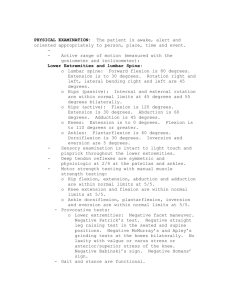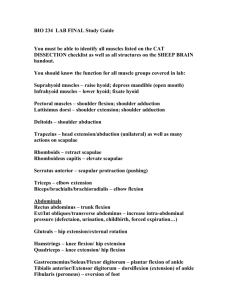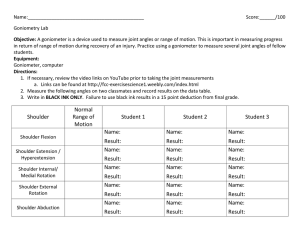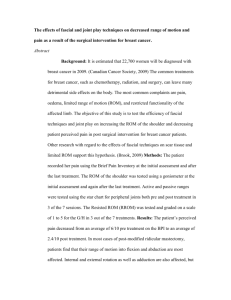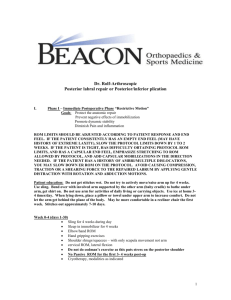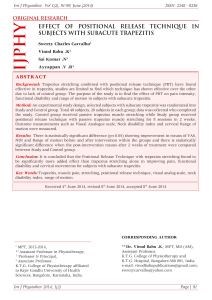Manual Equipment
advertisement
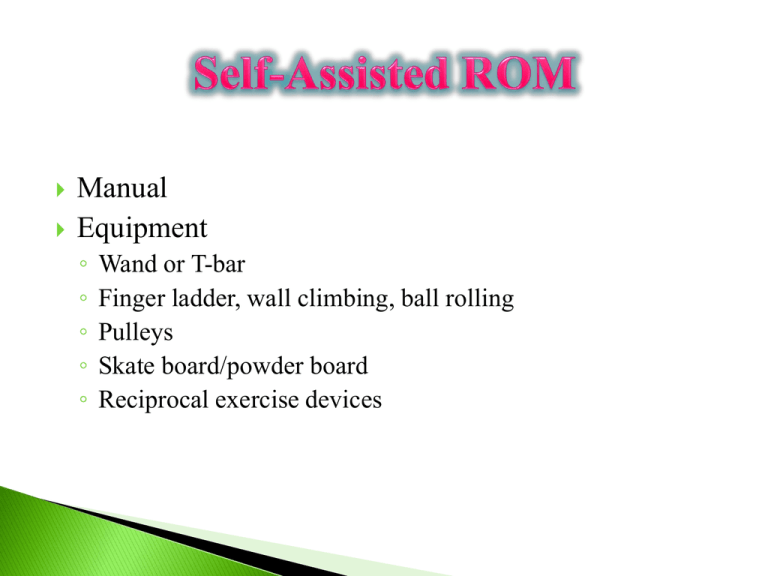
Manual Equipment ◦ ◦ ◦ ◦ ◦ Wand or T-bar Finger ladder, wall climbing, ball rolling Pulleys Skate board/powder board Reciprocal exercise devices Self-Asisted ROM (S-AROM) should be part of the home exercise program Done as soon as the individual is able to understand and learn what to do used to protect the healing tissues when more intensive muscle contraction is contraindicated Manual Equipment ◦ ◦ ◦ ◦ ◦ Wand or T-bar Finger ladder, wall climbing, ball rolling Pulleys Skate board/powder board Reciprocal exercise devices Educate the patient on the value of the motion. Ensure correct body alignment, stabilization, and performance If equipment is used, ensure safe application. Provide drawings and clear guidelines for number of repetitions and frequency. Review the exercises at a follow-up session. Modify or progress based on the patient response cases of unilateral weakness or paralysis, or during early stages of recovery after trauma or surgery The effects of gravity with patient positioning Shoulder flexion and extension. Shoulder horizontal abduction and adduction. Shoulder rotation. Elbow flexion and extension. Pronation and supination of the forearm. Wrist flexion and extension and radial and ulnar deviation. Finger flexion and extension. Thumb flexion with opposition and extension with reposition. Hip and knee flexion. Hip abduction and adduction. Combined hip abduction with external rotation. Ankle and Toes Patient has voluntary muscle control in an involved upper extremity but needs guidance or motivation to complete the ROM ◦ provide the patient with objective reinforcement and motivation for performing shoulder ROM arm may be moved into flexion or abduction utilize significantly more muscle activity than therapist-assisted ROM and CPM machines A pulley may also be attached to an overhead bar or affixed to the ceiling a friction-free surface may encourage movement without the resistance of gravity or friction ◦ skate with rollers ◦ using powder ◦ placing a towel under the extremity Providing some flexion and extension to an involved extremity using the strength of the normal extremity ◦ bicycle, upper body, or lower body ergometer, or a reciprocal exercise unit reciprocal exercise unit can be used also for reciprocal patterning, endurance training, and strengthening passive motion performed by a mechanical device that moves a joint slowly and continuously through a controlled ROM. It has beneficial healing effects on diseased or injured joint structures and soft tissues Prevents development of adhesions and contractures Provides a stimulating effect on the healing of tendons and ligaments Enhances healing of incisions over the moving joint Increases synovial fluid lubrication of the joint Prevents the degrading effects of immobilization Provides a quicker return of ROM Decreases postoperative pain Apply immediately after surgery or as soon as possible use low arc of motion (20°-30°) initially and progress to 10°-15°/day as tolerated Use 1 cycle/45 sec or 2 min continuous for 24 hrs - continuous for 1 hr 3x day PT is done when pt. is not on CPM The duration is usually less than 1 week determine what pattern of movement is desired and then move the extremity through that pattern beneficial in initiating the teaching of ADL helps the patient to: ◦ recognize the purpose and value of ROM exercises ◦ develop motor patterns Grasping an eating utensil Eating (hand to mouth) Reaching to various shelf heights Brushing or combing back of hair Holding a phone to the ear Donning or doffing a shirt or jacket Reaching out a car window to an ATM machine Going from supine to sitting at the side of a bed Standing up/sitting down and walking Putting on socks and shoes
